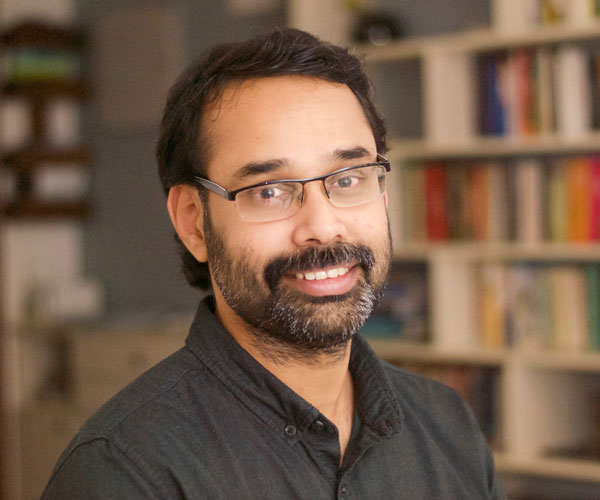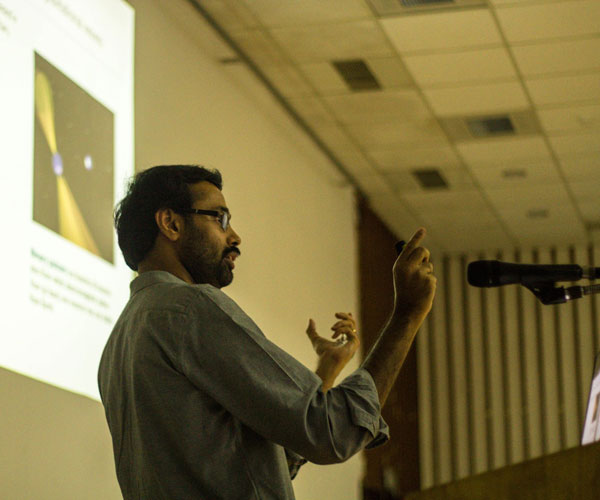Ajith Parameswaran, an Indian astrophysicist from Bengaluru, is the winner of the 2020 TWAS-CAS Young Scientist Award for Frontier Science. He received this prestigious recognition "For his pioneering contributions to the development of phenomenological models of gravitational-wave signals from coalescing binary black holes."
Before Ajith Parameswaran became an astrophysicist, he had dreams of being a cinematographer. But even though he didn't achieve his original goal, his career shift shows how failure can serve as the foundation for a successful new beginning.
He first moved to physics and then to astrophysics, becoming a brilliant researcher in the field and an esteemed member of the international collaboration called LIGO/VIRGO. This collaboration aims to inaugurate a new branch of astronomy through the observation of cosmic gravitational waves. (LIGO stands for Laser Interferometer Gravitational-Wave Observatory, while Virgo is its sister observatory in Italy).
"I did not expect this recognition," he admitted. "I knew I was nominated, and I felt very honoured and humbled when I received the news. I have high respect for TWAS and its activities connecting the international scientific community, especially developing countries. And I have huge respect for Abdus Salam, a major figure in modern physics."
Parameswaran is an associate professor with the International Centre for Theoretical Sciences - Tata Institute of Fundamental Research in Bengaluru, India, and a principal investigator in the Astrophysical Relativity group. He earned his PhD at the Max Planck Institute for Gravitational Physics (Albert Einstein Institute) and was a postdoctoral scholar at the Albert Einstein Institute and California Institute of Technology.
Gravitational waves recently supplemented electromagnetic waves as the primary tool astronomers use to observe the universe, he explained. "Gravitational waves offer a completely different way to observe the universe, a new branch of astronomy."
Gravitational waves were predicted by Einstein's Theory of General Relativity and were first detected in 2015, by the LIGO-Virgo Collaboration. They are extremely tiny disturbances – similar to ripples in the water – that travel at the speed of light through the fabric of space-time.
Detecting them is a challenge: The signals from gravitational waves are very weak and usually buried in detector noise. "The best way to extract gravitational wave signals is to compare the incoming data with theoretical models of the expected signals," he explained.
For some sources of gravitational waves, such as binary star systems of black holes, it is possible to construct accurate models of the expected signals. The first slow-paced part is called the inspiral phase, in which two celestial objects rotate one around the other; then, as they get closer and closer they accelerate almost up to the speed of light and eventually coalesce into a more massive, spinning black hole.
"In the inspiral phase, we can describe the system's evolution using an approximation of Einstein’s theory, called the post-Newtonian approximation. But in the later phases, these approximation techniques do not work, and we need to resort to supercomputer calculations."
The pioneering idea to merge the 'old-fashioned' analytical calculations using the post-Newtonian theory with the computational power of supercomputers - in what is called the 'phenomenological method' - led Parameswaran to obtain accurate models of gravitational waves from coalescing black hole binaries.
What do gravitational waves sound like? Actually, since they are generated and propagated in the vacuum of the space, they make no sound. But since their frequencies are in the ‘audio’ frequency band, scientists can convert these signals to audible sound [here is a multimedia representation of the first observed GW signal - Credit: LIGO/Caltech/MIT].
Theoretical models constructed using his ‘phenomenological method’ are now widely used in international experiments like LIGO/VIRGO to extract the properties of faraway sources from gravitational-wave observations. This also helps confirm that the signals astronomers observe are consistent with Einstein’s theory of General Relativity.
As a member of the team that discovered gravitational waves, he was also the recipient of the 2016 Special Breakthrough Prize in Fundamental Physics and the 2016 Gruber Cosmology Prize. He has also received the Ramanujan Fellowship from the Government of India, the CIFAR Azrieli Global Scholarship from the Canadian Institute for Advanced Research, and was the head of a Max Planck Society’s Partner Group at the International Centre for Theoretical Sciences.
His dynamic team of about 10 people includes postdocs, faculty members and young students. In the last 3 years, they have been exploring a new and exciting topic called the gravitational lensing of gravitational waves: Einstein’s theory predicts that clusters of matter interposed between a source of light and an observer, will bend the light due to their gravity while it travels towards the observer. Astronomers have been regularly observing this phenomenon for over 100 years. It turns out that gravitational waves are also ‘lensed’ by massive objects in the same fashion.
"We have not observed this phenomenon directly, but there is a high chance that we can observe it in the next few years," is Parameswaran's optimistic view. But for now, he is focused on the present and the potential benefits stemming from the TWAS award. “This award not only brings important recognition," maintained the scientist. "I hope it will help us to attract better and better people to our group. We are a still relatively young community, a young institution, and a young group. Still, we are making quite an impact. We certainly want to do better in the future, and this recognition will help us to do better."
However, his career is not limited to research. He is also actively involved in science outreach and community development and works closely with the Jawaharlal Nehru Planetarium in Bangalore.
Cristina Serra
About the TWAS-CAS Young Scientist Award for Frontier Science
The TWAS-CAS Young Scientist Award for Frontier Science is a newly-established award offered by TWAS in partnership with the Chinese Academy of Sciences (CAS) and the Lenovo company, a global leader in consumer, commercial, and enterprise technology today the largest PC company in the world. The prize, which CAS President and former TWAS President Bai Chunli strongly supported, honours scientists not older than 45 living and working in developing countries and carries a cash award of USD10,000. This year it recognizes achievements in the physical sciences, including physics and chemistry.

